2023 Quantifying the Impact of Irrigation and Precipitation Timings on Winter Wheat Yield and Quality
Link to Quantifying the Impact of Irrigation and Precipitation Timings on Winter Wheat
Yield and Quality PDF
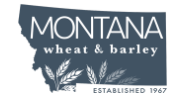
Project Title:
2023 Quantifying the Impact of Irrigation and Precipitation Timings on Winter Wheat Yield and Quality
Objective:
To determine the agronomic impacts of the various irrigation strategies and simulated rain winter wheat cultivars.
Personnel:
Marilyn Dalen,Daniel Porter, J.A. Torrion
Summary:
This study was arranged in a split-plot design, where the water regime was the main plot, and eight winter wheat (four soft whites and four hard reds) cultivars were the subplot. This study was duplicated to an additional environment allowing us to simulate the effect of additional rainfall received using an overhead irrigation sprinkler occurring during the grain-filling duration and evaluate its impact on yield and grain quality. See Table 1 for management information.
The yield, protein content, falling number, and test weight of the winter wheat were significantly affected by different water regimes treatment (Figures 1, 2, 4, 6). This year, irrigation at any amount increased yield in relation to the rainfed treatment. However, all irrigated treatments had the same yield. The optimum yield was already achieved by applying irrigation only at the flowering stage. (Figure 1). For 2023 cropping year (Sept. 2022 to Aug, 2023), the total precipitation received was 14.0 inches which was twice the amount from 2022 cropping year (7.6 inches). Higher moisture stored in spring and their occurrences early in the spring was provided an advantage for yield this season. There was an observed 17 bu/A yield gain across water regimes in an environment where a total additional 0.75” rainfall was simulated using the overhead sprinkler (three events at 0.25” each within grain fill).
For grain protein content, rainfed and 66ET (deficit treatment) showed higher protein content compared to 100ET (no stress) water regimes (Figure 2). Grain protein increased slightly (0.45%) under rainfed and 66ET (deficit treatment). Furthermore, grain protein content decreased as yield increased (Figure 3). The hard reds varieties (Flathead, FourOSix, Northern, and Bobcat) had an average grain protein of 10.9%. Whereas the soft white varieties had lower average grain protein of 9.9%.
Falling number also responded to the different water regimes treatment (Figure 4). Falling number under the 100ET (with no stress) had the lowest falling number (331 sec) compared to other water regimes treatments (ranging from 341-361 sec). This means that extending irrigation application towards the later grain filling stage induces late alpha-amylase activity in the grain. Application of the final irrigation for the season within the milking stage (100ETF) is beneficial to mitigate further decrease of falling number. The hard reds showed higher falling numbers compared with the soft whites (Figure 5). Specifically, Northern variety had the highest falling number whereas Bobtail and Sockeye had the lowest falling number. Overall, irrigation application regardless of the amount increased winter wheat test weight. Even though rainfed had the lowest test weight, winter wheat test weights were above 60 lb/bu (Figure 6).
Table 1. Management Information
| Seeding date: | 9/27/2022 (270 Julian) | Field Location: | R4 |
| Seeding rate: | Standard | Harvest date: | 8/1-2/23 (213-214 Julian) |
| Previous crop: | Canola | Soil type: | Creston Sandy Loam |
| Herbicide: | Axial Bold 15oz/A, CleanSweepM 1pt/A | Tillage: | Conventional |
| Insecticide: | N/A | Soil residual nutrient (NO3-, P, K lb/A): | 29.5-8-38 (Fall, 2022) |
| Fungicide: | Headline 6oz/A | Nutrient fertilizer applied (N, P2O5, K2O lb/A): | 10 lbs N (Fall, 2022) 120 lbs N (Spring, 2023) |
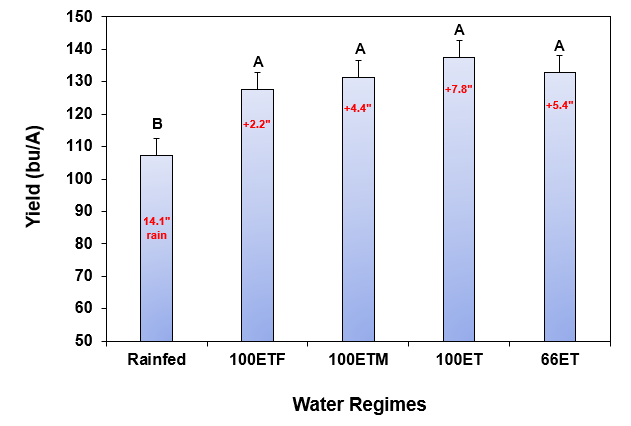
Figure 1. Yield responses with water regimes. The ‘+’ symbols are the irrigation amounts received per treatment. The 100 percent evapotranspiration (100ET) is with no stress. The 100ETF is a no-stress treatment until after flowering (the final irrigation was applied within the flowering stage). The 100ETM is also a no-stress treatment until after milk (the final irrigation was applied at the milk stage). The 66ET is the deficit treatment (applying only 2/3 of what was applied in the 100ET treatment at each irrigation event). The same letter assignment denotes non-significance at α=0.05.

Figure 2. Grain protein content responses with water regimes. The 100 percent evapotranspiration (100ET) is with no stress. The 100ETF is a no-stress treatment until after flowering (the final irrigation was applied within the flowering stage). The 100ETM is also a no-stress treatment until after milk (the final irrigation was applied at the milk stage). The 66ET is the deficit treatment (applying only 2/3 of what was applied in the 100ET treatment at each irrigation event). The same letter assignment denotes non-significance at α=0.05.
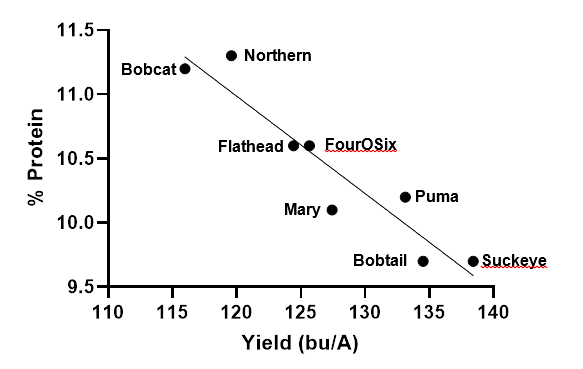
Figure 3. Grain protein and yield relationship of the varieties. The hard reds are Flathead, FourOSix, Northern, and Bobcat. The soft whites are Mary, Puma, Bobtail, and Sockeye.
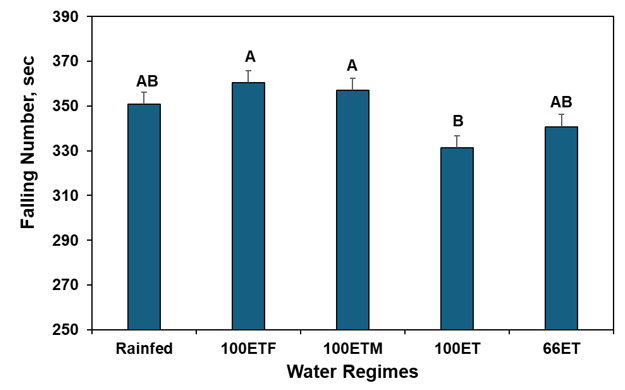
Figure 4. Falling number response with water regimes. The 100 percent evapotranspiration (100ET) is with no stress. The 100ETF is a no-stress treatment until after flowering (the final irrigation was applied within the flowering stage). The 100ETM is also a no-stress treatment until after milk (the final irrigation was applied at the milk stage). The 66ET is the deficit treatment (applying only 2/3 of what was applied in the 100ET treatment at each irrigation event). The same letter assignment denotes non-significance at α=0.05.

Figure 5. Falling number response with varieties.
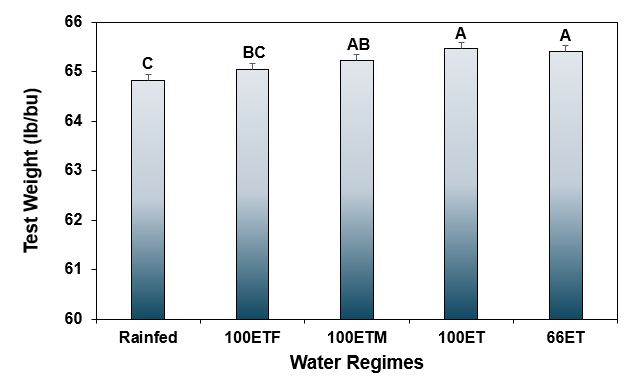
Figure 6. Test weight response with water regimes. The 100 percent evapotranspiration (100ET) is with no stress. The 100ETF is a no-stress treatment until after flowering (the final irrigation was applied within the flowering stage). The 100ETM is also a no-stress treatment until after milk (the final irrigation was applied at the milk stage). The 66ET is the deficit treatment (applying only 2/3 of what was applied in the 100ET treatment at each irrigation event). The same letter assignment denotes non-significance at α=0.05.
